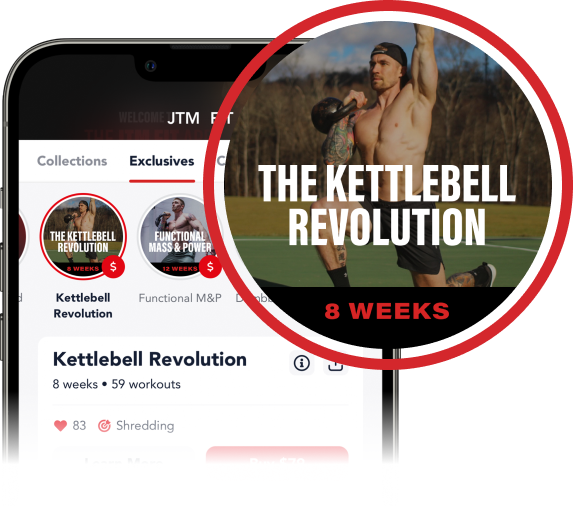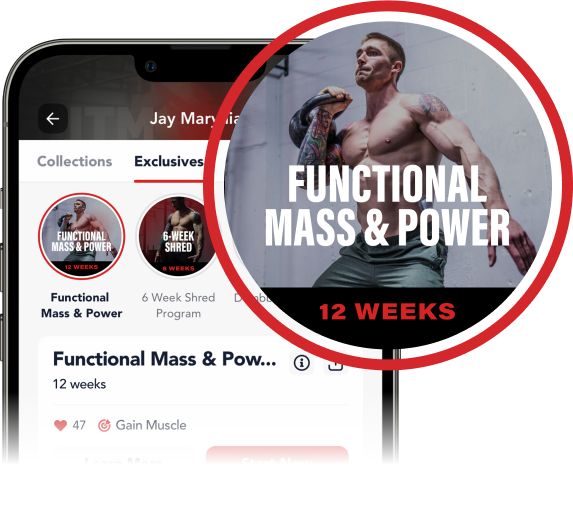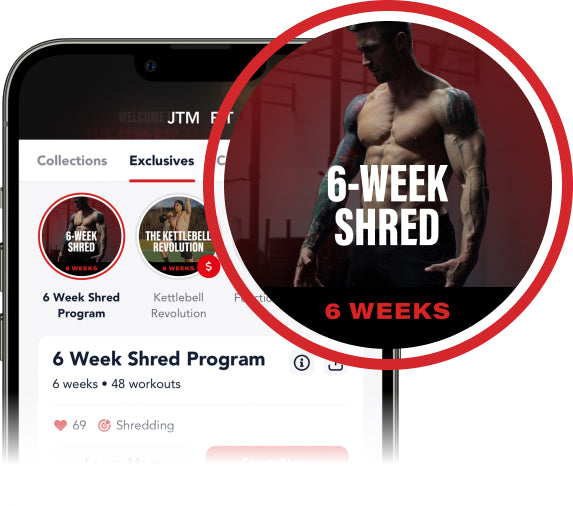Functional fitness is about training your body to move the way it was designed to move. Every single exercise you do, whether using bodyweight, dumbbells, kettlebells, or barbells, comes back to eight fundamental movement patterns.
Master these, and you'll be stronger, faster, more injury resilient, and performing better in the gym and in everyday life.
Over my 17+ years as a coach, I've watched thousands of men and women transform their bodies and lives through functional strength training exercises. The secret isn't complicated programs or fancy equipment; it's about mastering the eight movement patterns that every human being needs to know.
Functional Fitness Movements: The Master List
These are the eight fundamental functional fitness movements every human should master:
-
Hip Hinge: Strengthens the posterior chain and protects your spine when lifting.
-
Carry: Builds raw, usable strength through grip, posture, and core stability.
-
Squat: Develops lower-body power and mobility for everyday sitting and standing.
-
Lunge: Trains single-leg strength, balance, and stability for daily movement.
-
Vertical Press: Improves shoulder strength, core stability, and overhead control.
-
Horizontal Press: Builds chest, shoulders, and triceps for pushing power.
-
Pull/Row: Strengthens the back, grip, and core through pulling movements.
-
Core: the epicenter of strength and injury resilience.
1. The Hip Hinge: The King of All Human Movement

The hip hinge is one of the most crucial patterns you'll ever learn. We're constantly picking things up off the floor and putting them down in our everyday lives, and of course in the gym as well.
This movement primarily targets your posterior chain - the hamstrings, glutes, lower back, and some of the mid and upper back. More importantly, you need to master this pattern to even get into position for many other functional movements.
Foundations First:
Start with bodyweight hip hinges before adding weight. Practice the movement by sitting back into a chair, then standing up without using your hands. Focus on feet shoulder width with toes straight ahead, slight bend of knees, push butt back first. Keep hips above your knees (not at knee level), chest and hips rise at the same time, and look down and ahead to keep spine neutral.
2. The Carry: Building Raw Functional Strength

We're constantly picking things up and carrying them for distances before putting them back down. Building carries into your routine once or twice per week is crucial for developing and maintaining raw functional strength and promoting longevity.
While carries work your entire body, they put special focus on grip and forearm strength, upper body strength and stability, and core strength and stability.
Master This, Remember That:
Two-arm farmers carry - the traditional foundation carry. Start with lighter weights and shorter distances (20-30 steps). Focus on maintaining perfect posture before increasing load or distance.
Remember, you need to master your hip hinge to even get into position to perform carries effectively and safely.
3. The Squat: The Pattern You Use Every Single Day

You squat constantly without even thinking about it. Sitting down onto chairs, couches, toilets, and standing back up again. You might even pick things up off the floor using more of a squat pattern versus a hip hinge.
The more proficient you are at squatting - your ability to squat, that mobility, the strength in your quads and glutes - the longer, healthier life you're going to live.
Starting Point And Movement Focus:
Master bodyweight squats first. Start with bodyweight squats to nail down your form and distance, then progress to weighted variations. Test your ankle mobility - if you can't keep heels down, elevate them on plates until mobility improves.
The squat works primarily the quads and the glutes, building the foundation for functional lower body strength.
4. The Lunge: Building Single Leg Strength and Stability

We use the lunge pattern every single day in countless ways. From basic activities like getting up off the floor, stretching, cleaning, playing with kids, all the way to walking, running, and climbing stairs.
You need single leg strength, balance, and stability to perform at your best in basic daily activities and athletic endeavors.
Movement Tip and Starting Point:
You can manipulate the lunge to target different muscles. Take a bigger step with more forward lean for glutes and hamstrings. Take a shorter step with an upright torso for more quad focus.
Start with back lunges to master the movement pattern. Control the descent - never slam your knee to the floor. Master this before progressing to walking lunges.
5. The Vertical Press: Building Shoulder Strength and Stability

The vertical press is highly functional - in one way or another, we're often putting things up and over our heads in everyday life and in the gym.
This movement works the shoulders (specifically the anterior delts) and triceps, while inherently building core strength and stability. Pressing load overhead requires your core to work extra hard to maintain good alignment and protect the spine.
Safety Points and a Critical Form Tip:
Where people get injured with vertical pressing is their lack of contraction and stability in the lower body and core. Always flex your quads, squeeze your glutes, and brace your core before you press. You need a strong foundation to press from.
Single arm shoulder press builds symmetry from side to side and puts more focus on core stability.
6. The Horizontal Press: A Life-Saving Movement Pattern

From pressing your own body up off the floor to pushing a door, all the way to sports and combat applications - horizontal pressing is everywhere.
While all functional patterns could be life-saving, this is especially true with horizontal pressing. If you're strong with this pattern, it could absolutely make a huge difference in saving your own life or somebody else's.
Foundation and Form:
Before you start pressing heavy weight, master pressing your own bodyweight effectively and safely. Master 10 perfect push-ups before adding weight to any horizontal press variation.
Externally rotate shoulders and keep elbows at a 45-degree angle during push-ups. Retract shoulder blades for a stable platform during any bench pressing.
7. The Pull/Row: Another Critical Movement Pattern

The pulling movement includes both vertical pulls and horizontal rows, working the same muscle groups - lats, rhomboids, mid and upper traps, rear delts, biceps, and brachialis. You're also building grip strength and core stability.
This is truly a survival movement pattern. You might need to climb and pull yourself up over a wall or object, climb a tree, or pull someone to safety. Just being able to hold yourself with straight arms from a pull-up bar for an extended period could be life-saving.
Build Progressively:
If you can't do a full pull-up, start with dead hangs to build grip strength, then progress to negatives. For rows, focus on pulling toward your belt line with elbows tight to your body, not flared out toward your traps.
Work both vertical and horizontal pulls for complete development.
8. The Core: Your Epicenter of Strength

When we talk about core, we're discussing much more than just six-pack muscles. We're talking about the deeper core musculature that often goes unseen and untrained, but plays a vital role in protecting your spine under load and giving you the ability to produce and transfer force to your extremities.
This is your epicenter of strength. If you want to throw harder, run faster, jump higher, lift heavier weights, or pick something up off the floor without throwing out your back, you need to train your core functionally.
A Superior Exercise:
The hollow body hold is superior to planks because the only limiting factor is your core strength, not shoulder fatigue. Your back must stay pinned to the ground, with no space between your back and the floor. Suck those abs in and keep your spine pinned down.
Start with 10-15 second hollow body holds. If too difficult, bend your knees or lower your arms to your sides.
The Foundation Is Just The Beginning:
Just knowing these patterns and mastering them is only the first step. The real transformation occurs when you follow a structured plan that guides you step by step every single day—a program that progresses you over time and fits into your lifestyle.
These eight functional movement patterns form the foundation that thousands of people have used to get stronger, leaner, and more functional. Whether your goal is to build muscle, move pain-free, or perform better athletically, these movements are non-negotiable.
Want to dive deeper into each movement pattern with detailed video instruction and progressive exercise variations? Sign up for the complete Functional Movement Mastery Course and master all eight patterns in just eight days.









